Legal System and Contracts in Australia
VerifiedAdded on 2023/06/08
|11
|3029
|325
AI Summary
This article discusses the legal system and contracts in Australia. It covers the principles of Hart’s three-part legal system, criminal justice system, and fraudulent misrepresentation. It also explains the elements of a valid contract and the right to enforce contractual terms.
Contribute Materials
Your contribution can guide someone’s learning journey. Share your
documents today.

0
Australian Commercial
Law
Australian Commercial
Law
Secure Best Marks with AI Grader
Need help grading? Try our AI Grader for instant feedback on your assignments.
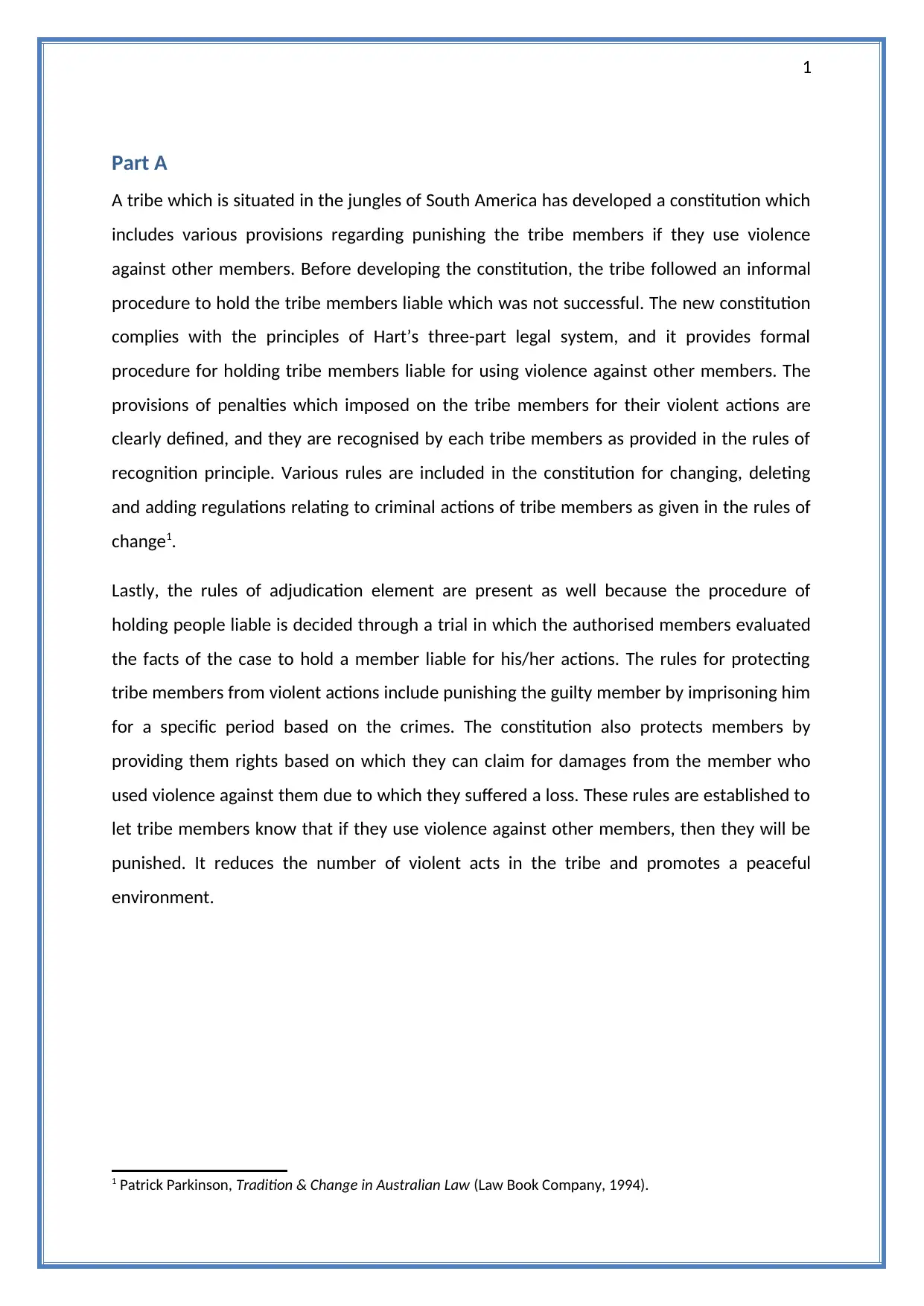
1
Part A
A tribe which is situated in the jungles of South America has developed a constitution which
includes various provisions regarding punishing the tribe members if they use violence
against other members. Before developing the constitution, the tribe followed an informal
procedure to hold the tribe members liable which was not successful. The new constitution
complies with the principles of Hart’s three-part legal system, and it provides formal
procedure for holding tribe members liable for using violence against other members. The
provisions of penalties which imposed on the tribe members for their violent actions are
clearly defined, and they are recognised by each tribe members as provided in the rules of
recognition principle. Various rules are included in the constitution for changing, deleting
and adding regulations relating to criminal actions of tribe members as given in the rules of
change1.
Lastly, the rules of adjudication element are present as well because the procedure of
holding people liable is decided through a trial in which the authorised members evaluated
the facts of the case to hold a member liable for his/her actions. The rules for protecting
tribe members from violent actions include punishing the guilty member by imprisoning him
for a specific period based on the crimes. The constitution also protects members by
providing them rights based on which they can claim for damages from the member who
used violence against them due to which they suffered a loss. These rules are established to
let tribe members know that if they use violence against other members, then they will be
punished. It reduces the number of violent acts in the tribe and promotes a peaceful
environment.
1 Patrick Parkinson, Tradition & Change in Australian Law (Law Book Company, 1994).
Part A
A tribe which is situated in the jungles of South America has developed a constitution which
includes various provisions regarding punishing the tribe members if they use violence
against other members. Before developing the constitution, the tribe followed an informal
procedure to hold the tribe members liable which was not successful. The new constitution
complies with the principles of Hart’s three-part legal system, and it provides formal
procedure for holding tribe members liable for using violence against other members. The
provisions of penalties which imposed on the tribe members for their violent actions are
clearly defined, and they are recognised by each tribe members as provided in the rules of
recognition principle. Various rules are included in the constitution for changing, deleting
and adding regulations relating to criminal actions of tribe members as given in the rules of
change1.
Lastly, the rules of adjudication element are present as well because the procedure of
holding people liable is decided through a trial in which the authorised members evaluated
the facts of the case to hold a member liable for his/her actions. The rules for protecting
tribe members from violent actions include punishing the guilty member by imprisoning him
for a specific period based on the crimes. The constitution also protects members by
providing them rights based on which they can claim for damages from the member who
used violence against them due to which they suffered a loss. These rules are established to
let tribe members know that if they use violence against other members, then they will be
punished. It reduces the number of violent acts in the tribe and promotes a peaceful
environment.
1 Patrick Parkinson, Tradition & Change in Australian Law (Law Book Company, 1994).
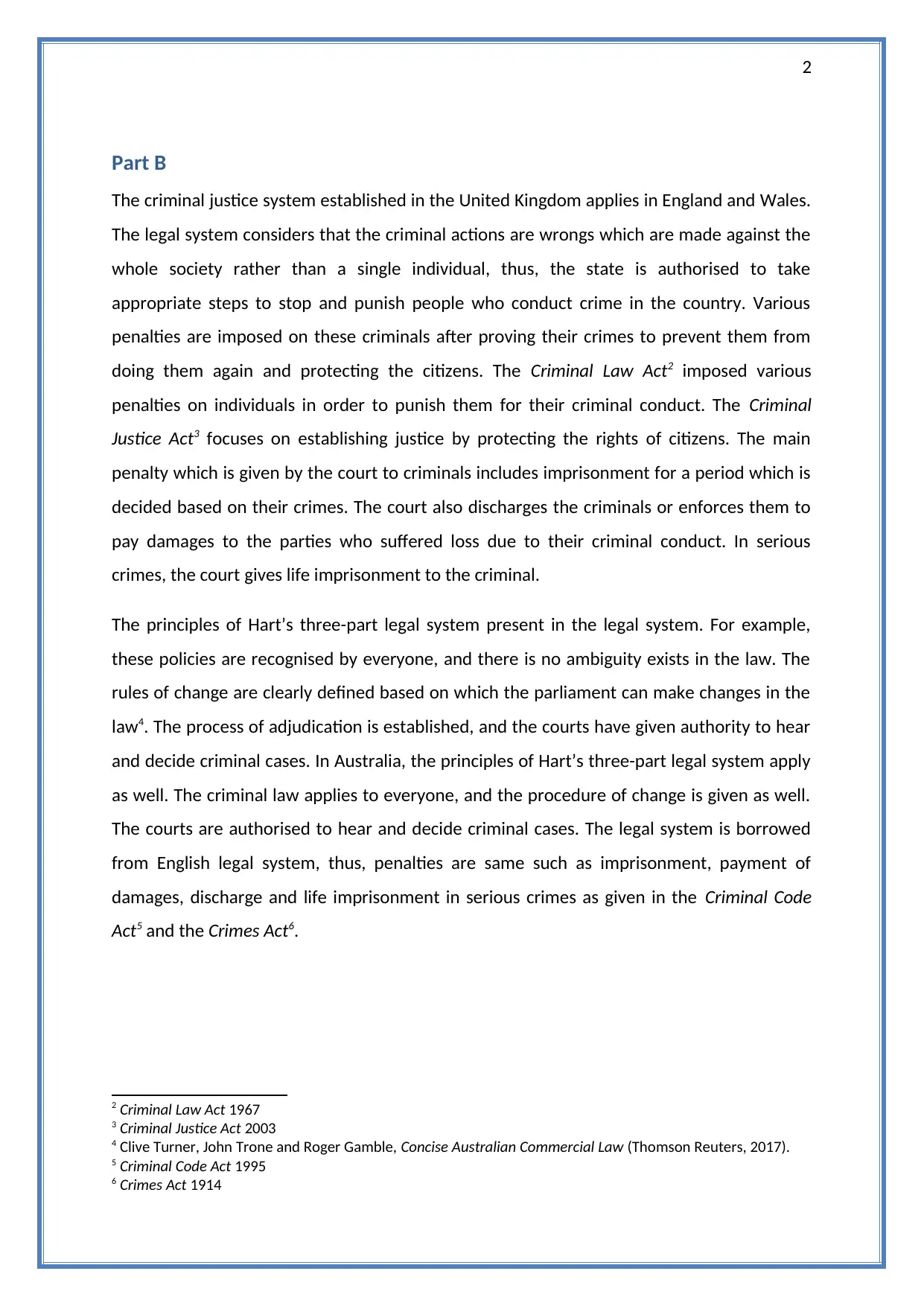
2
Part B
The criminal justice system established in the United Kingdom applies in England and Wales.
The legal system considers that the criminal actions are wrongs which are made against the
whole society rather than a single individual, thus, the state is authorised to take
appropriate steps to stop and punish people who conduct crime in the country. Various
penalties are imposed on these criminals after proving their crimes to prevent them from
doing them again and protecting the citizens. The Criminal Law Act2 imposed various
penalties on individuals in order to punish them for their criminal conduct. The Criminal
Justice Act3 focuses on establishing justice by protecting the rights of citizens. The main
penalty which is given by the court to criminals includes imprisonment for a period which is
decided based on their crimes. The court also discharges the criminals or enforces them to
pay damages to the parties who suffered loss due to their criminal conduct. In serious
crimes, the court gives life imprisonment to the criminal.
The principles of Hart’s three-part legal system present in the legal system. For example,
these policies are recognised by everyone, and there is no ambiguity exists in the law. The
rules of change are clearly defined based on which the parliament can make changes in the
law4. The process of adjudication is established, and the courts have given authority to hear
and decide criminal cases. In Australia, the principles of Hart’s three-part legal system apply
as well. The criminal law applies to everyone, and the procedure of change is given as well.
The courts are authorised to hear and decide criminal cases. The legal system is borrowed
from English legal system, thus, penalties are same such as imprisonment, payment of
damages, discharge and life imprisonment in serious crimes as given in the Criminal Code
Act5 and the Crimes Act6.
2 Criminal Law Act 1967
3 Criminal Justice Act 2003
4 Clive Turner, John Trone and Roger Gamble, Concise Australian Commercial Law (Thomson Reuters, 2017).
5 Criminal Code Act 1995
6 Crimes Act 1914
Part B
The criminal justice system established in the United Kingdom applies in England and Wales.
The legal system considers that the criminal actions are wrongs which are made against the
whole society rather than a single individual, thus, the state is authorised to take
appropriate steps to stop and punish people who conduct crime in the country. Various
penalties are imposed on these criminals after proving their crimes to prevent them from
doing them again and protecting the citizens. The Criminal Law Act2 imposed various
penalties on individuals in order to punish them for their criminal conduct. The Criminal
Justice Act3 focuses on establishing justice by protecting the rights of citizens. The main
penalty which is given by the court to criminals includes imprisonment for a period which is
decided based on their crimes. The court also discharges the criminals or enforces them to
pay damages to the parties who suffered loss due to their criminal conduct. In serious
crimes, the court gives life imprisonment to the criminal.
The principles of Hart’s three-part legal system present in the legal system. For example,
these policies are recognised by everyone, and there is no ambiguity exists in the law. The
rules of change are clearly defined based on which the parliament can make changes in the
law4. The process of adjudication is established, and the courts have given authority to hear
and decide criminal cases. In Australia, the principles of Hart’s three-part legal system apply
as well. The criminal law applies to everyone, and the procedure of change is given as well.
The courts are authorised to hear and decide criminal cases. The legal system is borrowed
from English legal system, thus, penalties are same such as imprisonment, payment of
damages, discharge and life imprisonment in serious crimes as given in the Criminal Code
Act5 and the Crimes Act6.
2 Criminal Law Act 1967
3 Criminal Justice Act 2003
4 Clive Turner, John Trone and Roger Gamble, Concise Australian Commercial Law (Thomson Reuters, 2017).
5 Criminal Code Act 1995
6 Crimes Act 1914
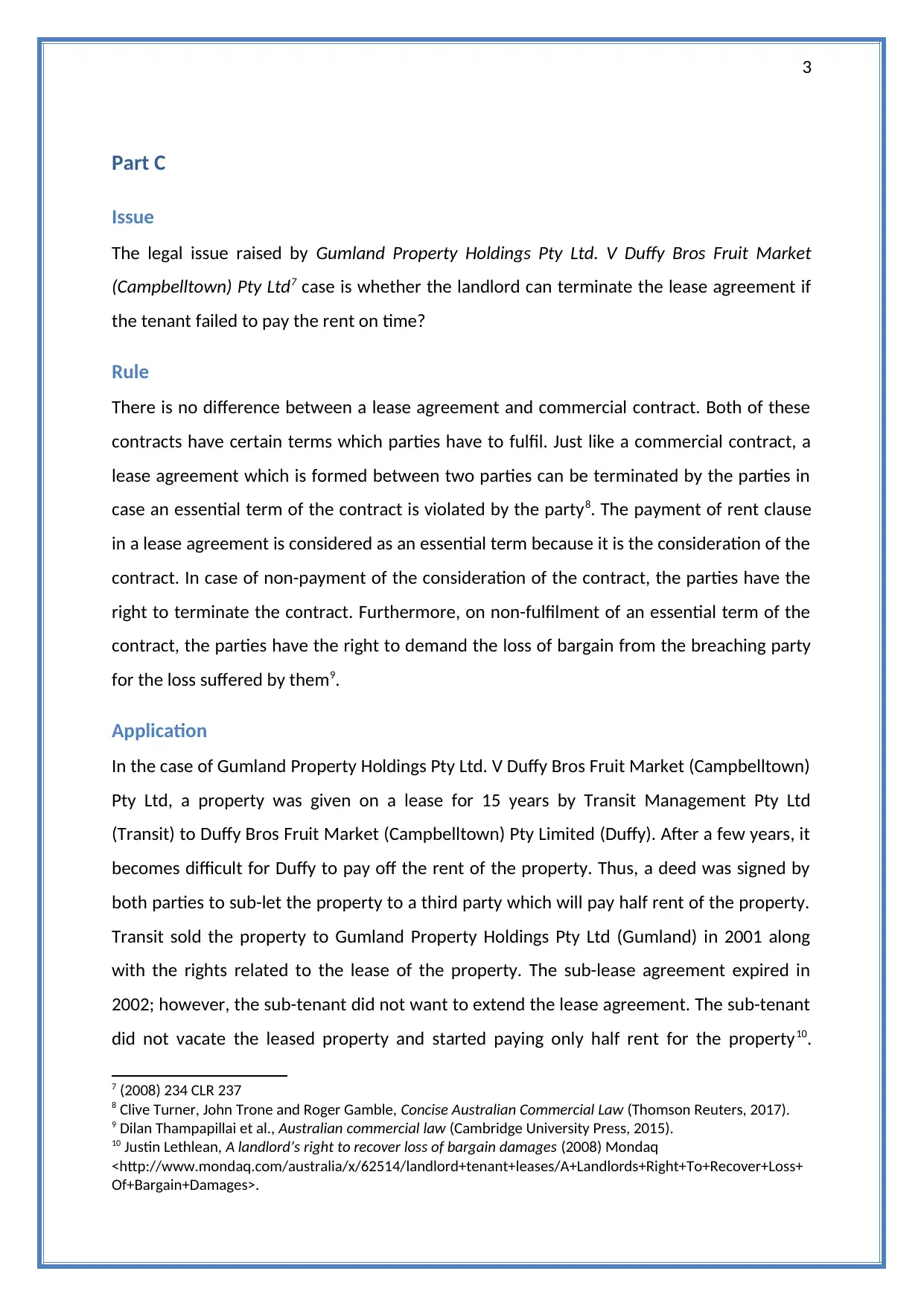
3
Part C
Issue
The legal issue raised by Gumland Property Holdings Pty Ltd. V Duffy Bros Fruit Market
(Campbelltown) Pty Ltd7 case is whether the landlord can terminate the lease agreement if
the tenant failed to pay the rent on time?
Rule
There is no difference between a lease agreement and commercial contract. Both of these
contracts have certain terms which parties have to fulfil. Just like a commercial contract, a
lease agreement which is formed between two parties can be terminated by the parties in
case an essential term of the contract is violated by the party8. The payment of rent clause
in a lease agreement is considered as an essential term because it is the consideration of the
contract. In case of non-payment of the consideration of the contract, the parties have the
right to terminate the contract. Furthermore, on non-fulfilment of an essential term of the
contract, the parties have the right to demand the loss of bargain from the breaching party
for the loss suffered by them9.
Application
In the case of Gumland Property Holdings Pty Ltd. V Duffy Bros Fruit Market (Campbelltown)
Pty Ltd, a property was given on a lease for 15 years by Transit Management Pty Ltd
(Transit) to Duffy Bros Fruit Market (Campbelltown) Pty Limited (Duffy). After a few years, it
becomes difficult for Duffy to pay off the rent of the property. Thus, a deed was signed by
both parties to sub-let the property to a third party which will pay half rent of the property.
Transit sold the property to Gumland Property Holdings Pty Ltd (Gumland) in 2001 along
with the rights related to the lease of the property. The sub-lease agreement expired in
2002; however, the sub-tenant did not want to extend the lease agreement. The sub-tenant
did not vacate the leased property and started paying only half rent for the property10.
7 (2008) 234 CLR 237
8 Clive Turner, John Trone and Roger Gamble, Concise Australian Commercial Law (Thomson Reuters, 2017).
9 Dilan Thampapillai et al., Australian commercial law (Cambridge University Press, 2015).
10 Justin Lethlean, A landlord’s right to recover loss of bargain damages (2008) Mondaq
<http://www.mondaq.com/australia/x/62514/landlord+tenant+leases/A+Landlords+Right+To+Recover+Loss+
Of+Bargain+Damages>.
Part C
Issue
The legal issue raised by Gumland Property Holdings Pty Ltd. V Duffy Bros Fruit Market
(Campbelltown) Pty Ltd7 case is whether the landlord can terminate the lease agreement if
the tenant failed to pay the rent on time?
Rule
There is no difference between a lease agreement and commercial contract. Both of these
contracts have certain terms which parties have to fulfil. Just like a commercial contract, a
lease agreement which is formed between two parties can be terminated by the parties in
case an essential term of the contract is violated by the party8. The payment of rent clause
in a lease agreement is considered as an essential term because it is the consideration of the
contract. In case of non-payment of the consideration of the contract, the parties have the
right to terminate the contract. Furthermore, on non-fulfilment of an essential term of the
contract, the parties have the right to demand the loss of bargain from the breaching party
for the loss suffered by them9.
Application
In the case of Gumland Property Holdings Pty Ltd. V Duffy Bros Fruit Market (Campbelltown)
Pty Ltd, a property was given on a lease for 15 years by Transit Management Pty Ltd
(Transit) to Duffy Bros Fruit Market (Campbelltown) Pty Limited (Duffy). After a few years, it
becomes difficult for Duffy to pay off the rent of the property. Thus, a deed was signed by
both parties to sub-let the property to a third party which will pay half rent of the property.
Transit sold the property to Gumland Property Holdings Pty Ltd (Gumland) in 2001 along
with the rights related to the lease of the property. The sub-lease agreement expired in
2002; however, the sub-tenant did not want to extend the lease agreement. The sub-tenant
did not vacate the leased property and started paying only half rent for the property10.
7 (2008) 234 CLR 237
8 Clive Turner, John Trone and Roger Gamble, Concise Australian Commercial Law (Thomson Reuters, 2017).
9 Dilan Thampapillai et al., Australian commercial law (Cambridge University Press, 2015).
10 Justin Lethlean, A landlord’s right to recover loss of bargain damages (2008) Mondaq
<http://www.mondaq.com/australia/x/62514/landlord+tenant+leases/A+Landlords+Right+To+Recover+Loss+
Of+Bargain+Damages>.
Secure Best Marks with AI Grader
Need help grading? Try our AI Grader for instant feedback on your assignments.
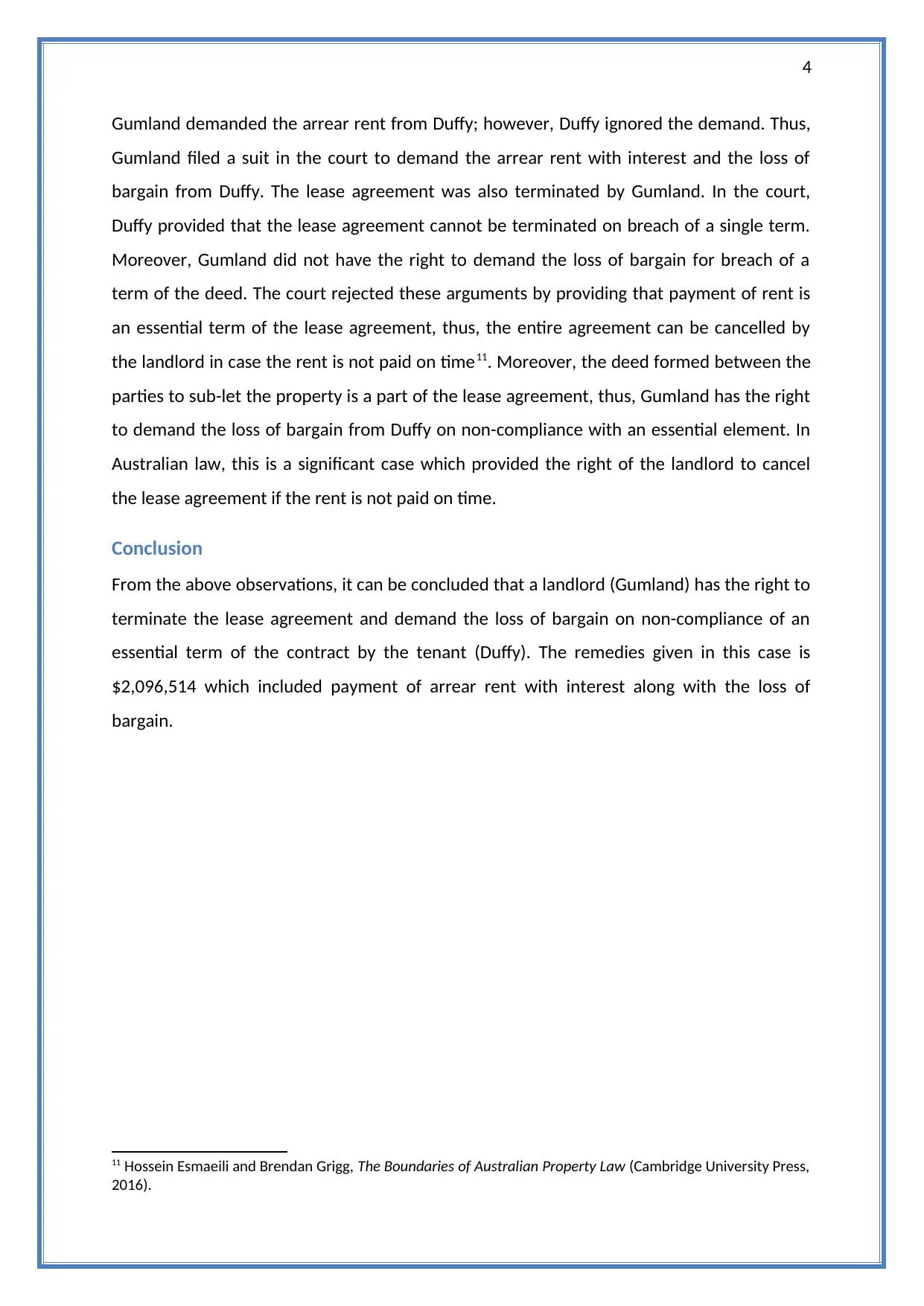
4
Gumland demanded the arrear rent from Duffy; however, Duffy ignored the demand. Thus,
Gumland filed a suit in the court to demand the arrear rent with interest and the loss of
bargain from Duffy. The lease agreement was also terminated by Gumland. In the court,
Duffy provided that the lease agreement cannot be terminated on breach of a single term.
Moreover, Gumland did not have the right to demand the loss of bargain for breach of a
term of the deed. The court rejected these arguments by providing that payment of rent is
an essential term of the lease agreement, thus, the entire agreement can be cancelled by
the landlord in case the rent is not paid on time11. Moreover, the deed formed between the
parties to sub-let the property is a part of the lease agreement, thus, Gumland has the right
to demand the loss of bargain from Duffy on non-compliance with an essential element. In
Australian law, this is a significant case which provided the right of the landlord to cancel
the lease agreement if the rent is not paid on time.
Conclusion
From the above observations, it can be concluded that a landlord (Gumland) has the right to
terminate the lease agreement and demand the loss of bargain on non-compliance of an
essential term of the contract by the tenant (Duffy). The remedies given in this case is
$2,096,514 which included payment of arrear rent with interest along with the loss of
bargain.
11 Hossein Esmaeili and Brendan Grigg, The Boundaries of Australian Property Law (Cambridge University Press,
2016).
Gumland demanded the arrear rent from Duffy; however, Duffy ignored the demand. Thus,
Gumland filed a suit in the court to demand the arrear rent with interest and the loss of
bargain from Duffy. The lease agreement was also terminated by Gumland. In the court,
Duffy provided that the lease agreement cannot be terminated on breach of a single term.
Moreover, Gumland did not have the right to demand the loss of bargain for breach of a
term of the deed. The court rejected these arguments by providing that payment of rent is
an essential term of the lease agreement, thus, the entire agreement can be cancelled by
the landlord in case the rent is not paid on time11. Moreover, the deed formed between the
parties to sub-let the property is a part of the lease agreement, thus, Gumland has the right
to demand the loss of bargain from Duffy on non-compliance with an essential element. In
Australian law, this is a significant case which provided the right of the landlord to cancel
the lease agreement if the rent is not paid on time.
Conclusion
From the above observations, it can be concluded that a landlord (Gumland) has the right to
terminate the lease agreement and demand the loss of bargain on non-compliance of an
essential term of the contract by the tenant (Duffy). The remedies given in this case is
$2,096,514 which included payment of arrear rent with interest along with the loss of
bargain.
11 Hossein Esmaeili and Brendan Grigg, The Boundaries of Australian Property Law (Cambridge University Press,
2016).

5
Part D
Issue
In Pryor v Given12 case, the issue raised whether the false statement made regarding a land
can be constituted as fraudulent misrepresentation to set aside the contract and whether
the party can be liable under the Australian Consumer Law?
Rule
A person can be held liable for making a fraudulent misrepresentation if a statement is
made by him that is false and the objective of such statement is to induce another party to
sign a contract. The person who knowingly, without believing the truth or recklessly made a
statement which is false to encourage another party to create a legal relationship can be
held liable for fraudulent misrepresentation13. The innocent party who suffered a loss due to
fraudulent misrepresentation has the right to set aside the contract or comply with its terms
since the contract becomes voidable if it is formed based on fraudulent misrepresentation.
The Australian Consumer Law provides various regulations to protect the customers from
fraud. Section 18 of the Competition and Consumer Act 2010 provides that a party can be
held liable for making a statement regarding trade or commerce which is misleading or
deceptive or likely to do. Section 30 of the act held a party liable for making a misleading or
deceptive statement regarding land or possible sale of the land14.
Application
In Pryor v Given case, a real estate company made an advertisement regarding selling a land.
The advertisement displayed a house on the land, and a quote was written that the house is
“a wonderful place to live”. The company depicted in the advertisement that a house can be
built on the land, however, the land which was advertised was subject to a planning
scheme. Based on such scheme, no house can be built on such land without fulfilment of a
wide range of legal conditions. The parties who wanted to build a house on such land have
to comply with difficult compliances and get the construction approved before building
12 (1979) 24 ALR 442
13 Clive Turner, John Trone and Roger Gamble, Concise Australian Commercial Law (Thomson Reuters, 2017).
14 Austlii, Competition and Consumer Act 2010 (2018) Austlii <
http://www5.austlii.edu.au/au/legis/cth/consol_act/caca2010265/>.
Part D
Issue
In Pryor v Given12 case, the issue raised whether the false statement made regarding a land
can be constituted as fraudulent misrepresentation to set aside the contract and whether
the party can be liable under the Australian Consumer Law?
Rule
A person can be held liable for making a fraudulent misrepresentation if a statement is
made by him that is false and the objective of such statement is to induce another party to
sign a contract. The person who knowingly, without believing the truth or recklessly made a
statement which is false to encourage another party to create a legal relationship can be
held liable for fraudulent misrepresentation13. The innocent party who suffered a loss due to
fraudulent misrepresentation has the right to set aside the contract or comply with its terms
since the contract becomes voidable if it is formed based on fraudulent misrepresentation.
The Australian Consumer Law provides various regulations to protect the customers from
fraud. Section 18 of the Competition and Consumer Act 2010 provides that a party can be
held liable for making a statement regarding trade or commerce which is misleading or
deceptive or likely to do. Section 30 of the act held a party liable for making a misleading or
deceptive statement regarding land or possible sale of the land14.
Application
In Pryor v Given case, a real estate company made an advertisement regarding selling a land.
The advertisement displayed a house on the land, and a quote was written that the house is
“a wonderful place to live”. The company depicted in the advertisement that a house can be
built on the land, however, the land which was advertised was subject to a planning
scheme. Based on such scheme, no house can be built on such land without fulfilment of a
wide range of legal conditions. The parties who wanted to build a house on such land have
to comply with difficult compliances and get the construction approved before building
12 (1979) 24 ALR 442
13 Clive Turner, John Trone and Roger Gamble, Concise Australian Commercial Law (Thomson Reuters, 2017).
14 Austlii, Competition and Consumer Act 2010 (2018) Austlii <
http://www5.austlii.edu.au/au/legis/cth/consol_act/caca2010265/>.

6
anything15. The objective of the real estate company by making that advertisement was to
induce potential customers to purchase the house by signing a legal contract because, in
reality, the company knew that a house could not be built on such land. A suit was filed
against the company and the court provided that the company has made a false
representation regarding the land in order to sign a contract with potential customers. The
court provided that the corporation has breached section 30 of the Australian Consumer
Law. The advertisement made by the company was misleading and deceptive because it
showed that a house could be built on the land, whereas, it is difficult to build a house on
such land without dealing with a wide range of legal compliances. Thus, the court provided
that the real estate company is liable for making a fraudulent misrepresentation and
breaching section 30 of the Australian Consumer Law, thus, any contract formed with the
company is voidable, and it can set aside by the parties.
Conclusion
From the above observations, it can be concluded that the company is liable for fraudulent
misrepresentation and breaching section 30 of the Australian Consumer Law based on the
misleading advertisement displayed by the company. The remedies given in this case
include terminating the contract regarding the purchase of such land and payment of
damages to the aggrieved parties.
15 Jade, Edward Alfred Pryor v Brian Alexander Given (1980) Jade < https://jade.io/article/192884 >.
anything15. The objective of the real estate company by making that advertisement was to
induce potential customers to purchase the house by signing a legal contract because, in
reality, the company knew that a house could not be built on such land. A suit was filed
against the company and the court provided that the company has made a false
representation regarding the land in order to sign a contract with potential customers. The
court provided that the corporation has breached section 30 of the Australian Consumer
Law. The advertisement made by the company was misleading and deceptive because it
showed that a house could be built on the land, whereas, it is difficult to build a house on
such land without dealing with a wide range of legal compliances. Thus, the court provided
that the real estate company is liable for making a fraudulent misrepresentation and
breaching section 30 of the Australian Consumer Law, thus, any contract formed with the
company is voidable, and it can set aside by the parties.
Conclusion
From the above observations, it can be concluded that the company is liable for fraudulent
misrepresentation and breaching section 30 of the Australian Consumer Law based on the
misleading advertisement displayed by the company. The remedies given in this case
include terminating the contract regarding the purchase of such land and payment of
damages to the aggrieved parties.
15 Jade, Edward Alfred Pryor v Brian Alexander Given (1980) Jade < https://jade.io/article/192884 >.
Paraphrase This Document
Need a fresh take? Get an instant paraphrase of this document with our AI Paraphraser
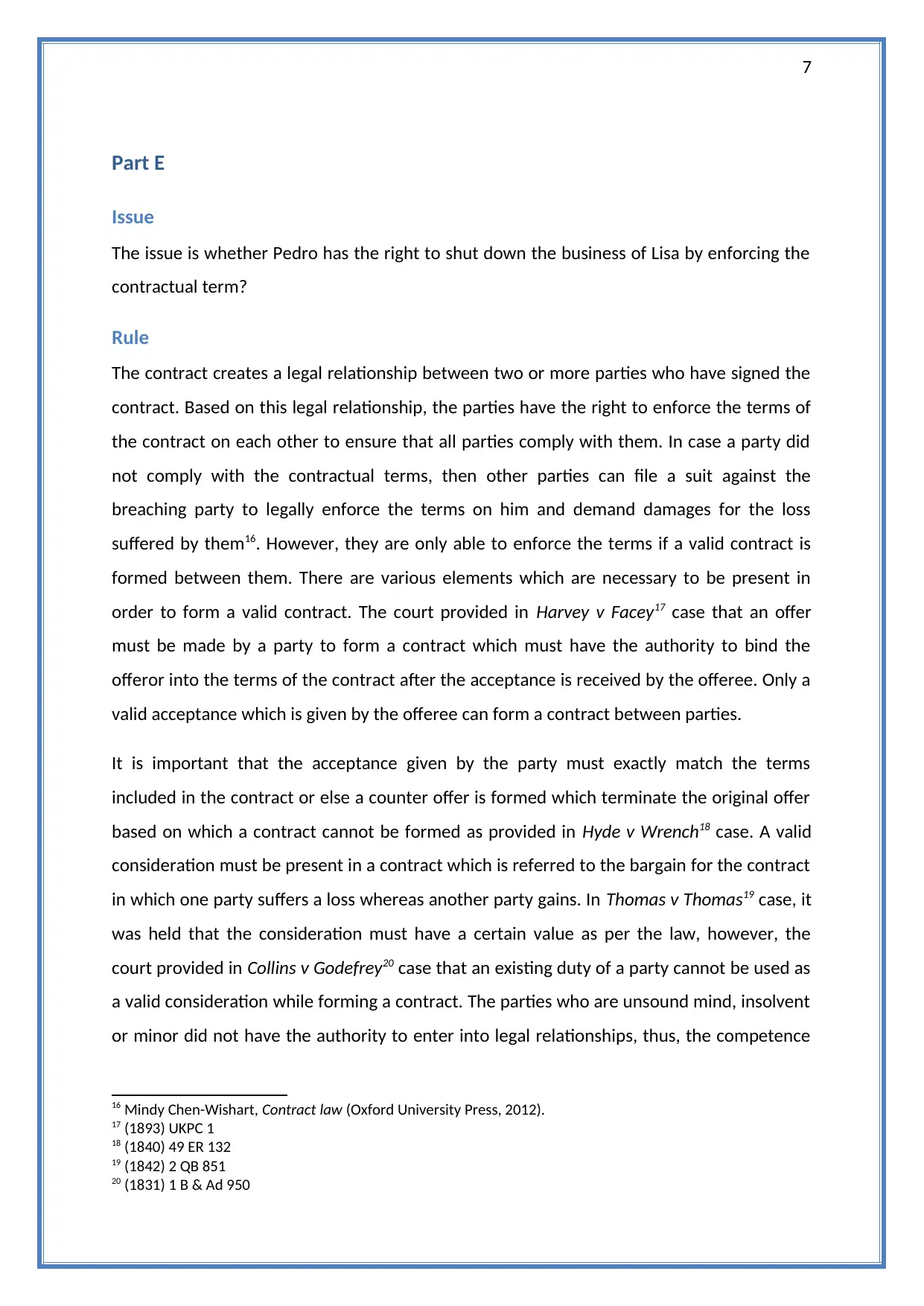
7
Part E
Issue
The issue is whether Pedro has the right to shut down the business of Lisa by enforcing the
contractual term?
Rule
The contract creates a legal relationship between two or more parties who have signed the
contract. Based on this legal relationship, the parties have the right to enforce the terms of
the contract on each other to ensure that all parties comply with them. In case a party did
not comply with the contractual terms, then other parties can file a suit against the
breaching party to legally enforce the terms on him and demand damages for the loss
suffered by them16. However, they are only able to enforce the terms if a valid contract is
formed between them. There are various elements which are necessary to be present in
order to form a valid contract. The court provided in Harvey v Facey17 case that an offer
must be made by a party to form a contract which must have the authority to bind the
offeror into the terms of the contract after the acceptance is received by the offeree. Only a
valid acceptance which is given by the offeree can form a contract between parties.
It is important that the acceptance given by the party must exactly match the terms
included in the contract or else a counter offer is formed which terminate the original offer
based on which a contract cannot be formed as provided in Hyde v Wrench18 case. A valid
consideration must be present in a contract which is referred to the bargain for the contract
in which one party suffers a loss whereas another party gains. In Thomas v Thomas19 case, it
was held that the consideration must have a certain value as per the law, however, the
court provided in Collins v Godefrey20 case that an existing duty of a party cannot be used as
a valid consideration while forming a contract. The parties who are unsound mind, insolvent
or minor did not have the authority to enter into legal relationships, thus, the competence
16 Mindy Chen-Wishart, Contract law (Oxford University Press, 2012).
17 (1893) UKPC 1
18 (1840) 49 ER 132
19 (1842) 2 QB 851
20 (1831) 1 B & Ad 950
Part E
Issue
The issue is whether Pedro has the right to shut down the business of Lisa by enforcing the
contractual term?
Rule
The contract creates a legal relationship between two or more parties who have signed the
contract. Based on this legal relationship, the parties have the right to enforce the terms of
the contract on each other to ensure that all parties comply with them. In case a party did
not comply with the contractual terms, then other parties can file a suit against the
breaching party to legally enforce the terms on him and demand damages for the loss
suffered by them16. However, they are only able to enforce the terms if a valid contract is
formed between them. There are various elements which are necessary to be present in
order to form a valid contract. The court provided in Harvey v Facey17 case that an offer
must be made by a party to form a contract which must have the authority to bind the
offeror into the terms of the contract after the acceptance is received by the offeree. Only a
valid acceptance which is given by the offeree can form a contract between parties.
It is important that the acceptance given by the party must exactly match the terms
included in the contract or else a counter offer is formed which terminate the original offer
based on which a contract cannot be formed as provided in Hyde v Wrench18 case. A valid
consideration must be present in a contract which is referred to the bargain for the contract
in which one party suffers a loss whereas another party gains. In Thomas v Thomas19 case, it
was held that the consideration must have a certain value as per the law, however, the
court provided in Collins v Godefrey20 case that an existing duty of a party cannot be used as
a valid consideration while forming a contract. The parties who are unsound mind, insolvent
or minor did not have the authority to enter into legal relationships, thus, the competence
16 Mindy Chen-Wishart, Contract law (Oxford University Press, 2012).
17 (1893) UKPC 1
18 (1840) 49 ER 132
19 (1842) 2 QB 851
20 (1831) 1 B & Ad 950

8
of parties is another key element21. Lastly, the parties forming a contract must have the
intention to bind themselves to the terms of the contract. In Jones v Padavatton22 case, the
court provided that people did not have the intention to form legal relationships in social
and domestic settings.
Application
Pedro and Lisa have formed a contract in which Pedro is purchasing the business of Lisa.
Both parties have formed a valid contract since all elements of fulfilled by them. Firstly, a
valid offer and acceptance are made along with a valid consideration. Both parties are
competent, and they have the intention to form a legal relationship. As per the term of the
contract, Lisa cannot open a French Jewellery business in Australia for a period of two years
since the contract is formed. Lisa has opened a French Jewellery business in Cairns,
Queensland after one year of the contract. Thus, Pedro can enforce the contractual terms
on Lisa to shut down her business.
Conclusion
From the above observations, it can be concluded that a valid contract has formed between
the parties. Therefore, Pedro has the right to shut down the business of Lisa to enforce the
contractual terms on her. The remedies available in this case include the specific
performance of the contractual terms and payment of damages to Pedro for the loss
suffered by him.
21 Clive Turner, John Trone and Roger Gamble, Concise Australian Commercial Law (Thomson Reuters, 2017).
22 (1969) 1 WLR 328
of parties is another key element21. Lastly, the parties forming a contract must have the
intention to bind themselves to the terms of the contract. In Jones v Padavatton22 case, the
court provided that people did not have the intention to form legal relationships in social
and domestic settings.
Application
Pedro and Lisa have formed a contract in which Pedro is purchasing the business of Lisa.
Both parties have formed a valid contract since all elements of fulfilled by them. Firstly, a
valid offer and acceptance are made along with a valid consideration. Both parties are
competent, and they have the intention to form a legal relationship. As per the term of the
contract, Lisa cannot open a French Jewellery business in Australia for a period of two years
since the contract is formed. Lisa has opened a French Jewellery business in Cairns,
Queensland after one year of the contract. Thus, Pedro can enforce the contractual terms
on Lisa to shut down her business.
Conclusion
From the above observations, it can be concluded that a valid contract has formed between
the parties. Therefore, Pedro has the right to shut down the business of Lisa to enforce the
contractual terms on her. The remedies available in this case include the specific
performance of the contractual terms and payment of damages to Pedro for the loss
suffered by him.
21 Clive Turner, John Trone and Roger Gamble, Concise Australian Commercial Law (Thomson Reuters, 2017).
22 (1969) 1 WLR 328
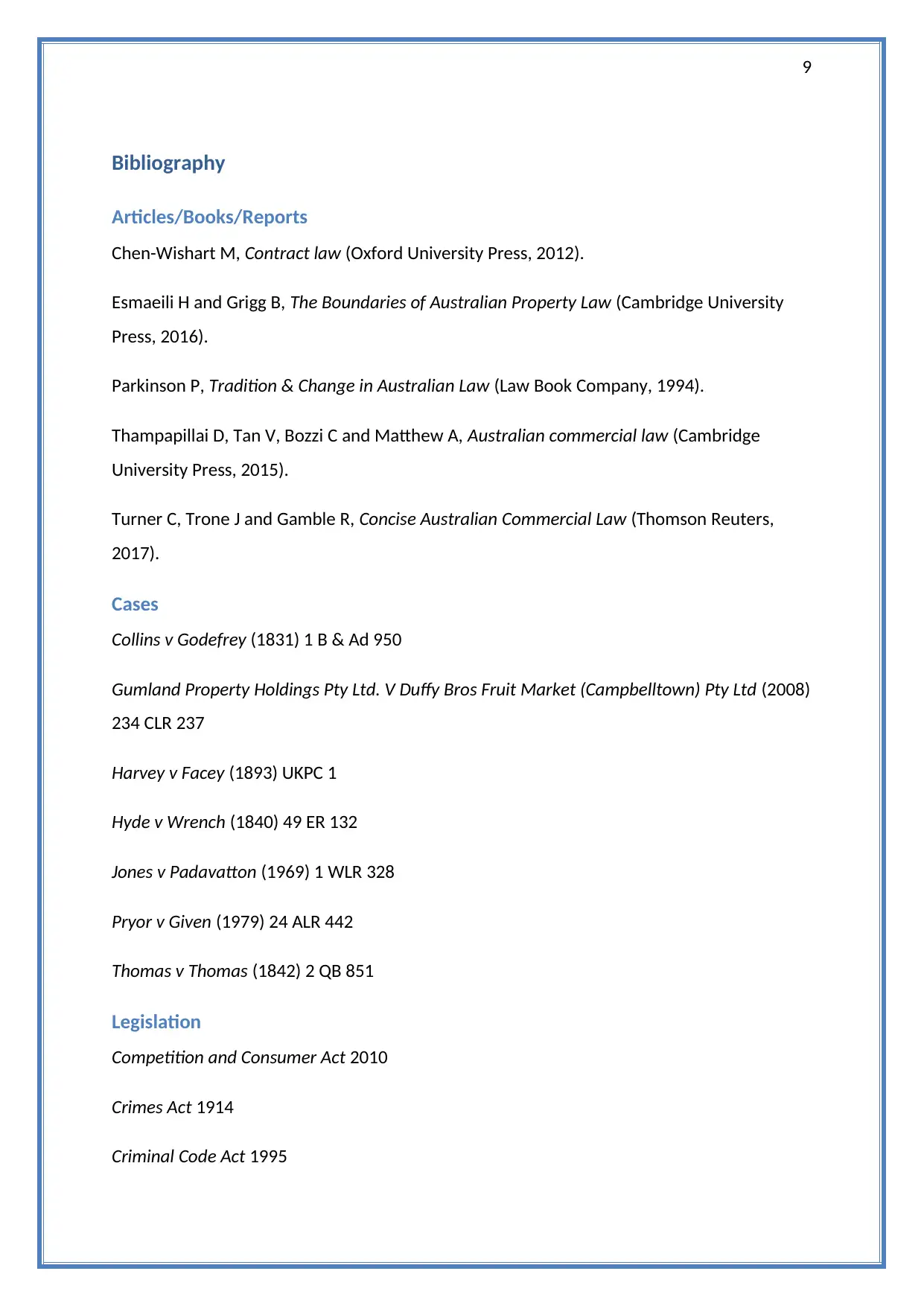
9
Bibliography
Articles/Books/Reports
Chen-Wishart M, Contract law (Oxford University Press, 2012).
Esmaeili H and Grigg B, The Boundaries of Australian Property Law (Cambridge University
Press, 2016).
Parkinson P, Tradition & Change in Australian Law (Law Book Company, 1994).
Thampapillai D, Tan V, Bozzi C and Matthew A, Australian commercial law (Cambridge
University Press, 2015).
Turner C, Trone J and Gamble R, Concise Australian Commercial Law (Thomson Reuters,
2017).
Cases
Collins v Godefrey (1831) 1 B & Ad 950
Gumland Property Holdings Pty Ltd. V Duffy Bros Fruit Market (Campbelltown) Pty Ltd (2008)
234 CLR 237
Harvey v Facey (1893) UKPC 1
Hyde v Wrench (1840) 49 ER 132
Jones v Padavatton (1969) 1 WLR 328
Pryor v Given (1979) 24 ALR 442
Thomas v Thomas (1842) 2 QB 851
Legislation
Competition and Consumer Act 2010
Crimes Act 1914
Criminal Code Act 1995
Bibliography
Articles/Books/Reports
Chen-Wishart M, Contract law (Oxford University Press, 2012).
Esmaeili H and Grigg B, The Boundaries of Australian Property Law (Cambridge University
Press, 2016).
Parkinson P, Tradition & Change in Australian Law (Law Book Company, 1994).
Thampapillai D, Tan V, Bozzi C and Matthew A, Australian commercial law (Cambridge
University Press, 2015).
Turner C, Trone J and Gamble R, Concise Australian Commercial Law (Thomson Reuters,
2017).
Cases
Collins v Godefrey (1831) 1 B & Ad 950
Gumland Property Holdings Pty Ltd. V Duffy Bros Fruit Market (Campbelltown) Pty Ltd (2008)
234 CLR 237
Harvey v Facey (1893) UKPC 1
Hyde v Wrench (1840) 49 ER 132
Jones v Padavatton (1969) 1 WLR 328
Pryor v Given (1979) 24 ALR 442
Thomas v Thomas (1842) 2 QB 851
Legislation
Competition and Consumer Act 2010
Crimes Act 1914
Criminal Code Act 1995
Secure Best Marks with AI Grader
Need help grading? Try our AI Grader for instant feedback on your assignments.
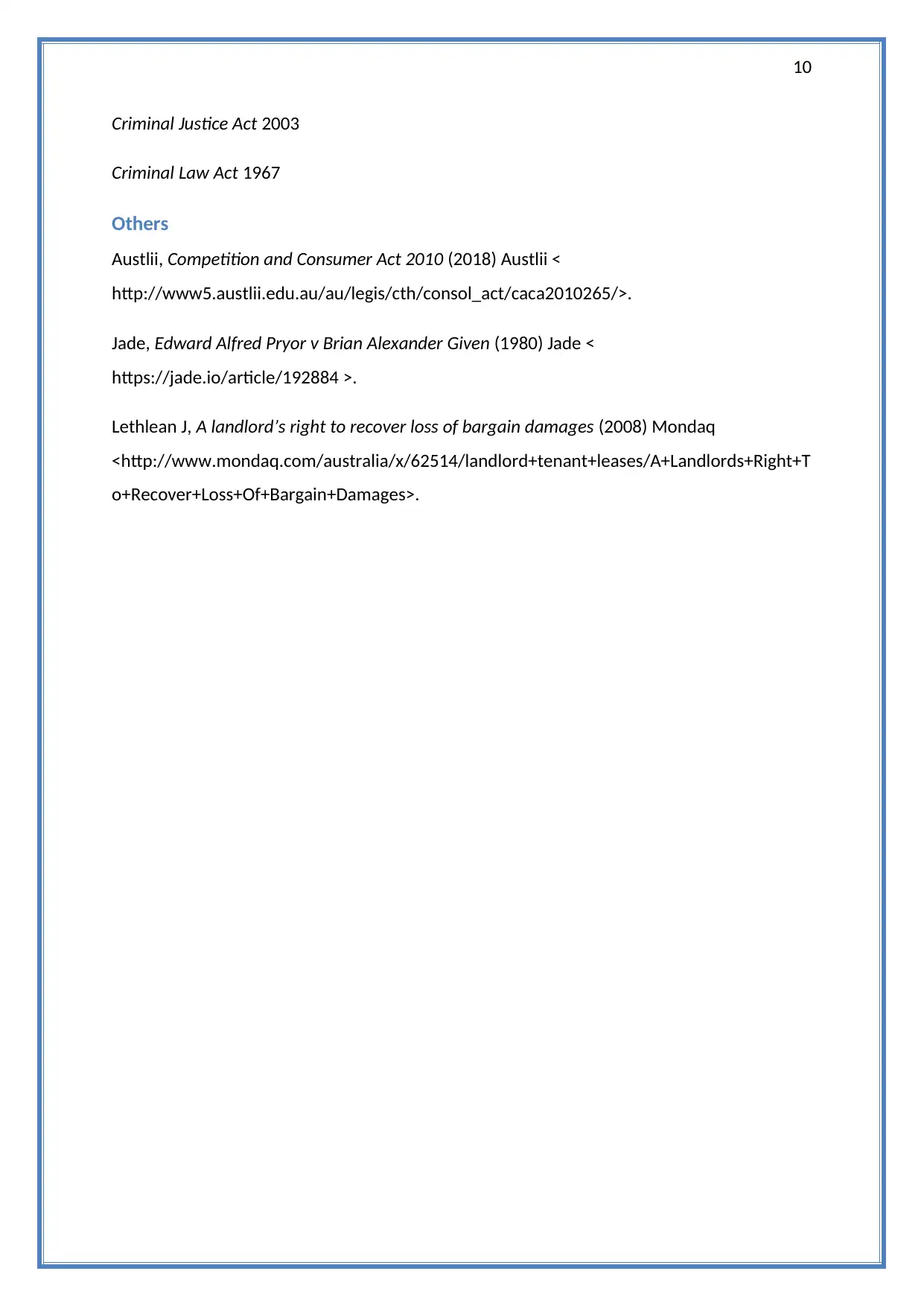
10
Criminal Justice Act 2003
Criminal Law Act 1967
Others
Austlii, Competition and Consumer Act 2010 (2018) Austlii <
http://www5.austlii.edu.au/au/legis/cth/consol_act/caca2010265/>.
Jade, Edward Alfred Pryor v Brian Alexander Given (1980) Jade <
https://jade.io/article/192884 >.
Lethlean J, A landlord’s right to recover loss of bargain damages (2008) Mondaq
<http://www.mondaq.com/australia/x/62514/landlord+tenant+leases/A+Landlords+Right+T
o+Recover+Loss+Of+Bargain+Damages>.
Criminal Justice Act 2003
Criminal Law Act 1967
Others
Austlii, Competition and Consumer Act 2010 (2018) Austlii <
http://www5.austlii.edu.au/au/legis/cth/consol_act/caca2010265/>.
Jade, Edward Alfred Pryor v Brian Alexander Given (1980) Jade <
https://jade.io/article/192884 >.
Lethlean J, A landlord’s right to recover loss of bargain damages (2008) Mondaq
<http://www.mondaq.com/australia/x/62514/landlord+tenant+leases/A+Landlords+Right+T
o+Recover+Loss+Of+Bargain+Damages>.
1 out of 11
Related Documents
Your All-in-One AI-Powered Toolkit for Academic Success.
+13062052269
info@desklib.com
Available 24*7 on WhatsApp / Email
![[object Object]](/_next/static/media/star-bottom.7253800d.svg)
Unlock your academic potential
© 2024 | Zucol Services PVT LTD | All rights reserved.



